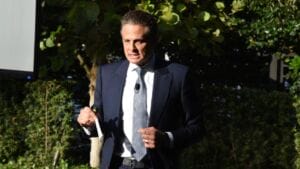The stock market continues to heat up and hit new highs. Here are a few ways to stay cool and not sweat the pressure of the markets.
Avoid the political distraction
It seems like we see a daily tweet from the political arena that makes us scratch our heads and wonder what it could mean for the markets. We have argued that political news affects the market in the short-term, but is nothing more than noise in the long-term.
Warren Buffet said, “If you are mixing politics with investment decisions, you’re making a big mistake.” Granted, it is difficult to ignore the political drama, but don’t stress over it. The fundamentals of the economy are what drive stock prices.
Don’t get burned by the shape of the yield curve
Many would argue that a flattening yield curve often signals an oncoming recession. I agree—however, historically, after a one percent drop in the spread between the six-month and 10-year Treasuries, there is typically a one- to two-year run in positive stock performance. The minimum gain in that two-year cycle has been 35 percent.
We are starting to see the yield curve flatten, but don’t cancel the picnic just yet. Since mid-June, when the spread dropped one percent, the S&P 500 is up only up 0.10 percent. The data suggests that we have another year or two of favorable equity returns. Don’t let the bond market burn you by getting out of the stock market too early.
Stay in the shade and watch for a correction
Corrections are normal and healthy for the market. Historically, on any given year, the market experiences both five and 10 percent corrections. Going back to 1930, during secular bull markets, we have seen a five percent correction every 84 trading days and a 10 percent correction every 331 trading days.
The last time we saw a five and 10 percent correction was 247 and 341 days ago, respectively, so history suggests we are due. Early last year, the S&P 500 corrected 11 percent. Precisely forecasting when a correction will occur, and to what magnitude, is difficult. Corrections come and go—long-term investors own quality companies and don’t sweat it.
Both temperature and humidity levels matter; similarly earnings and sales growth are paramount
I’ve been told that Arizona has a dry heat, meaning the temperature is high with little humidity, creating a manageable climate. Perhaps similar to stock prices, earnings and sales growth need to be analyzed together. Eventually, earnings drive stock prices.
After seven quarters of negative earnings growth, the earnings recession ended in the third quarter of 2016. In the first quarter of 2017, earnings grew 18 percent and revenue growth was up eight percent.
Sales growth is just as important, since it is subject to less manipulation. Earnings growth can increase by cost cuts or share repurchases—neither are sustainable. Sooner or later you need sales growth.
If the temperature and humidity are tolerable this summer, enjoy a swim. If earnings and sales growth are favorable, stay in the investment pool.
Take a vacation from the Fed
Everyone is aware that the Federal Reserve (the Fed) is in the process of normalizing short-term interest rates. The economic fundamentals are strong enough to support their move toward a more natural short-term interest rate—a rate close to the inflation rate.
The Federal Open Market Committee (FOMC) has made it very clear that its normalization strategy will be implemented at a slow, measured pace that can be supported by the economic fundamentals. As a chorus of “policy error” trickles through the markets, take in a summer concert or some tunes on the beach. The FOMC will not topple your sand castle this summer.
This summer, the temperatures may be hot, but the fundamentals of the economy are cool as a cucumber. Second quarter economic activity has improved materially, and we expect real gross domestic product (GDP) during the second half of 2017 will be better than 2.5 percent. In the first quarter of the year, corporate earnings grew 18 percent, and we expect approximately 15 percent earnings growth for calendar year 2017. The fundamentals are looking bright, so enjoy the remainder of summer.
KC Mathews is chief investment officer for UMB Bank.



